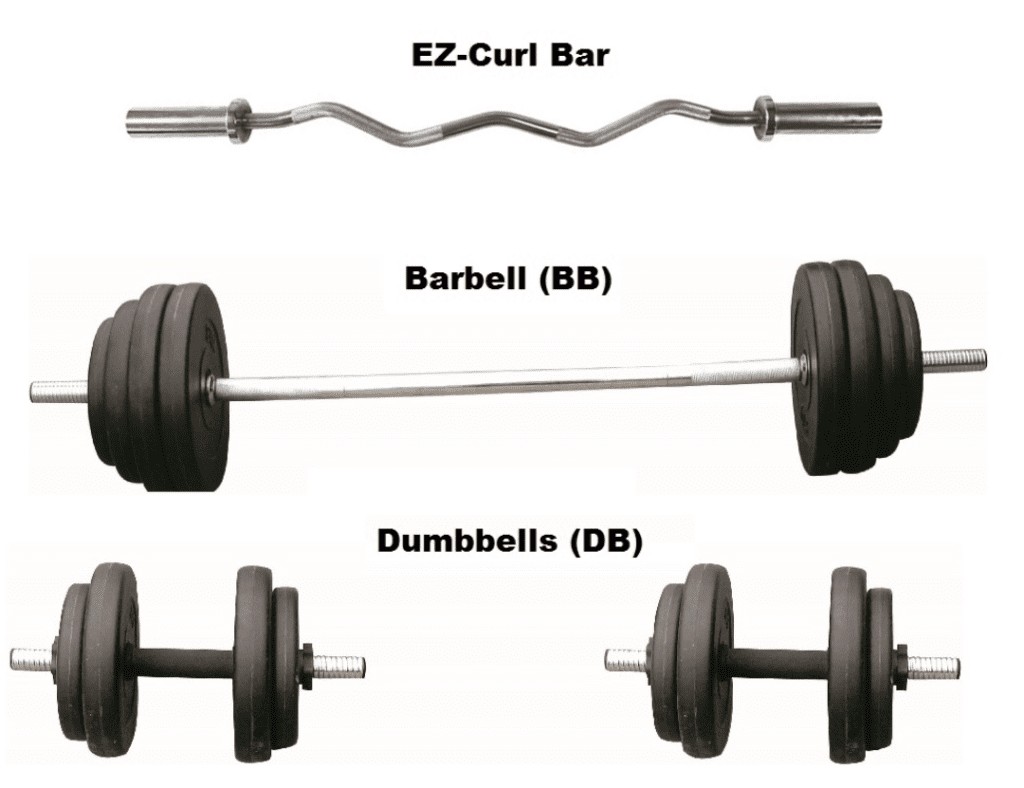
This page gives a quick explanation of some of the weightlifting terminology you might come across in a training article and may not understand.
Terminology
For those new to lifting, a few terms coming up might be confusing. Below you’ll find images of an EZ-Curl Bar, Barbell, and Dumbbells.

Sets and Reps
A “rep” is a repetition, which is how many times you repeat the movement before stopping. If I do 10 press-ups, i’ve done 10 “reps” of press-ups. If I rest, then do another 10 reps, that’s two “sets”. If you see “3 x 8” written in a workout, that is shorthand for “3 sets of 8 reps” – meaning do 8 reps, rest, 8 reps, rest, 8 reps.
Drop Sets
This is where you complete an exercise, and immediately reduce the weight and lift again. You can repeat this more than once, but the emphasis is on keeping the rest to an absolute minimum (under 5 secs) and is normally done with multiple sets of weights or a partner to assist you. An example could be bench press with 100kg, then 80kg, then 60kg, then 40kg.
Supersets
Similar to above, but instead of doing the same exercise, you will do another one straight after. This could be a bicep exercise, followed by another bicep exercise, or a bicep exercise followed by a tricep exercise. The second option allows you to train multiple muscle groups in a shorter space of time. The notation for this will usually be A1 Exercise One A2 Exercise Two. If there’s a second superset in the same workout it would be labelled B1, B2.
ATG
This stands for Ass To Grass, and is in relation to back (or front) squats. There is a lot of criticism thrown at those who don’t squat below parallel (hip bone level with the top of the knee), and those who sink right down so their bum almost touches the floor are said to be squatting “Ass To Grass”.
AMRAP
This is shorthand for As Many Reps As Possible. It’s exactly as it sounds, if this is written somewhere then you are expected to complete as many repetitions of the exercise as you can with good form.
EMOM
This is shorthand for Every Minute On The Minute. You start the exercise 60 seconds after you started the last set, instead of after you finished the last set. If you had a timer it would run continuously and you would start each set at 0:00, 1:00, 2:00, 3:00 etc. The benefit of this is to keep you completing each set as efficiently as possible, because otherwise it is eating away into your recovery time. If it takes you 45 seconds to finish, you get 15 seconds rest, whereas if you can complete all the reps in 30 seconds, you get 30 seconds rest.
Concentric
The ‘concentric’ part of the lift is where the muscle involved will shorten. For a bicep curl that’s when you are lifting the weight up towards you shoulder. For a squat, it is the part of the movement where you are coming back up to standing position. If you are looking to increase muscle size, this is generally the less important part of the lift, but always good to use proper form.
Eccentric
The ‘eccentric’ part of the lift is where the muscle involved will lengthen. For a bicep curl that’s when you are lowering the weight down to your waist. For a squat, it is the first part of the movement where you lower yourself from a standing position. If you are looking to increase muscle size, this is the most important part of the lift. Focus on taking 3-4 seconds to lower the weight on each rep. Your eccentric strength will be stronger than your concentric strength i.e. you can slowly lower a heavier weight than you can curl, so you will fail to lift a weight before you fail to lower it. Bodybuilders use spotters to help get an extra few reps out at the end of each set to maximise eccentric fatigue.
Delayed Onset Muscle Soreness
This is known as “DOMS”, and it is the muscle soreness you experience 12-48 hours after a workout. When you lift weights you are creating very small tears in your muscle fibres, which then build back stronger. Most of the muscle tears occur during the eccentric phase of the movement. To reduce the effects of DOMS, you can have a cold shower an hour after your workout and consume adequate protein. Generally a sudden increase in intensity, or a new exercise, will cause the most DOMS.

